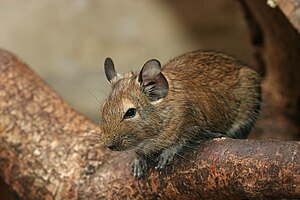Trug rats
| Trug rats | ||||||||||||
|---|---|---|---|---|---|---|---|---|---|---|---|---|

Ordinary degu ( Octodon degus ) |
||||||||||||
| Systematics | ||||||||||||
|
||||||||||||
| Scientific name | ||||||||||||
| Octodontidae | ||||||||||||
| Waterhouse , 1840 |
The Trug rats (Octodontidae) are a rodent family living in South America from the suborder of the porcupine relatives (Hystricomorpha). The family comprises eight genera with around 13 species, of which the common degu , which is sometimes kept as a pet in Germany, is the best known.
features
Trug rats get their name from the external resemblance to rats , with which they are not closely related. They are small rodents with a thick, mostly brown, gray or black colored fur. They have a relatively large head and a pointed snout. The eyes are rather large, the ears are large and rounded in the species that live on the surface, and small in the subterranean species (such as the Coruro ). They owe their scientific name Octodontidae (in English "eight teeth") to the chewing surface of their molars, which is shaped like the number 8 or like a kidney. The tooth formula is I 1 - C 0 - P 1 - M 3, so you have a total of 20 teeth.
The limbs are short, the forefeet ends in four and the hind legs in five toes, all of which have strong claws. The tail is built differently depending on the way of life, in the burrowing species it is short and bare, in the species living on the surface, however, it is long and often bushy. Trug rats reach a head body length of 12 to 31 centimeters and a weight of 60 to 700 grams.
A special feature of the turtle rats is that the number of chromosomes varies considerably depending on the species. There are karyotypes from 2n = 38 to 2n = 102. With the red and golden viscacha rats , the only known tetraploid mammals (with four sets of chromosomes) also belong to this group.
distribution and habitat
Trug rats are native to southern South America, their distribution area includes southern Bolivia , western Argentina and Chile . They have adapted to different habitats and are found in the coastal shrubland as well as in the high mountains at 3500 meters.
Way of life
Many species can dig well and live in earthworks, some genera (especially Coruros) have specialized in an underground way of life. Many species live in groups and have developed complex social structures. Trug rats are herbivores that feed on tubers, roots, bulbs, stems and the like. The female gives birth to one to ten young animals once or twice a year.
Systematics
The trough rats are counted among the guinea pig relatives within the rodents . Their sister group are the crested rats , which are sometimes even classified as a subfamily of the Trug rats. They may also be closely related to the chinchilla rats.
The family comprises eight genera with 14 species:
- South American rock rats ( Aconaemys ), 3 species
- Shrub rats or Degus ( Octodon ), 4 species
- Brushtail Rat ( Octodontomys gliroides )
- Viscacha rat ( Octomys mimax )
- Golden viscacha rat ( Pipanacoctomys aureus )
- Chalchaleros viscacha rat ( Salinoctomys loschalchalerosorum )
- Coruro ( Spalacopus cyanus )
- Tympanoctomys , 2 species
The Golden and Chalchaleros Viscacha rats were first described in 2000 and are specialized inhabitants of salt deserts. Systematically, these two species are closely related to the red viscacha rat ( Tympanoctomys barrerae ) and the Kirchner viscacha rat ( Tympanoctomys kirchnerorum ).
literature
- Ronald M. Nowak: Walker's Mammals of the World. 2 volumes. 6th edition. Johns Hopkins University Press, Baltimore MD et al. 1999, ISBN 0-8018-5789-9 .
- Don E. Wilson , DeeAnn M. Reeder (Eds.): Mammal Species of the World. A taxonomic and geographic Reference. 2 volumes. 3. Edition. Johns Hopkins University Press, Baltimore MD 2005, ISBN 0-8018-8221-4 .
Web links
Individual evidence
- ↑ Milton H. Gallardo, G. Kausel, A. Jiménez, C. Bacquet, C. González, J. Figueroa, N. Köhler, R. Ojeda: Whole-genome duplications in South American desert rodents (Octodontidae) . In: Biological Journal of the Linnean Society . tape 82 , no. 4 , 2004, p. 443–451 , doi : 10.1111 / j.1095-8312.2004.00331.x ( PDF [accessed October 27, 2013]).